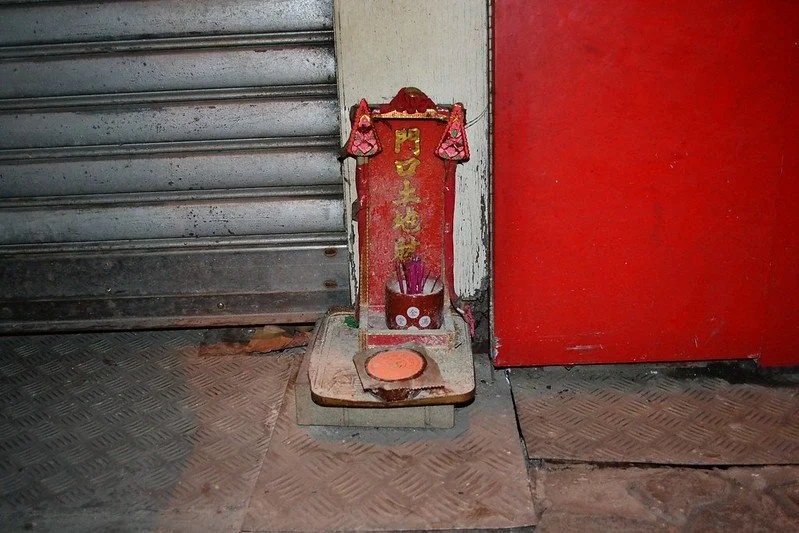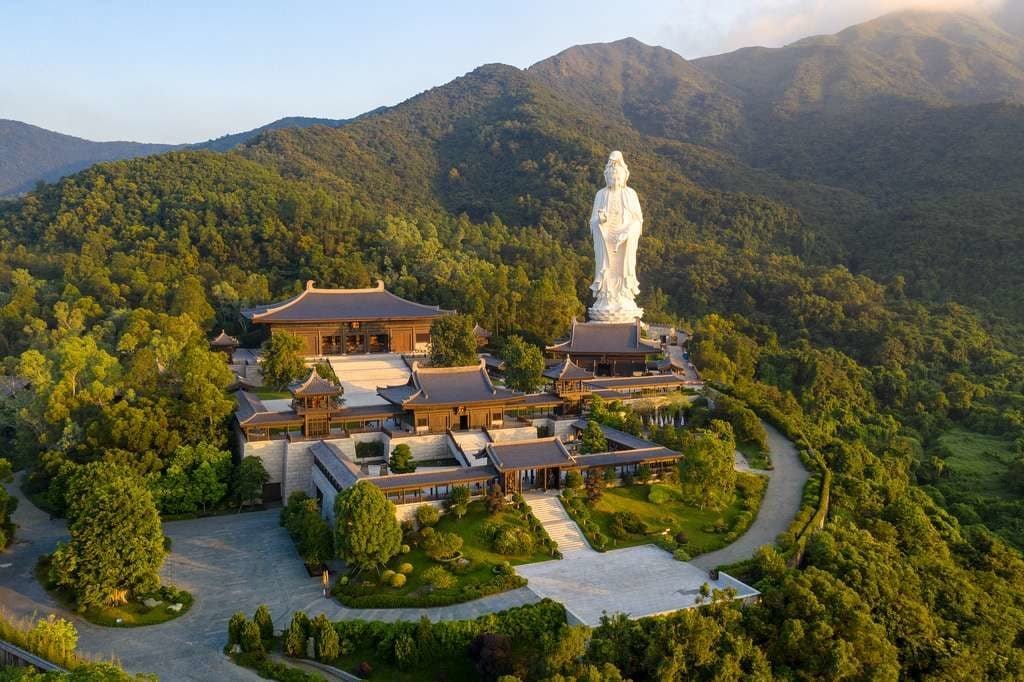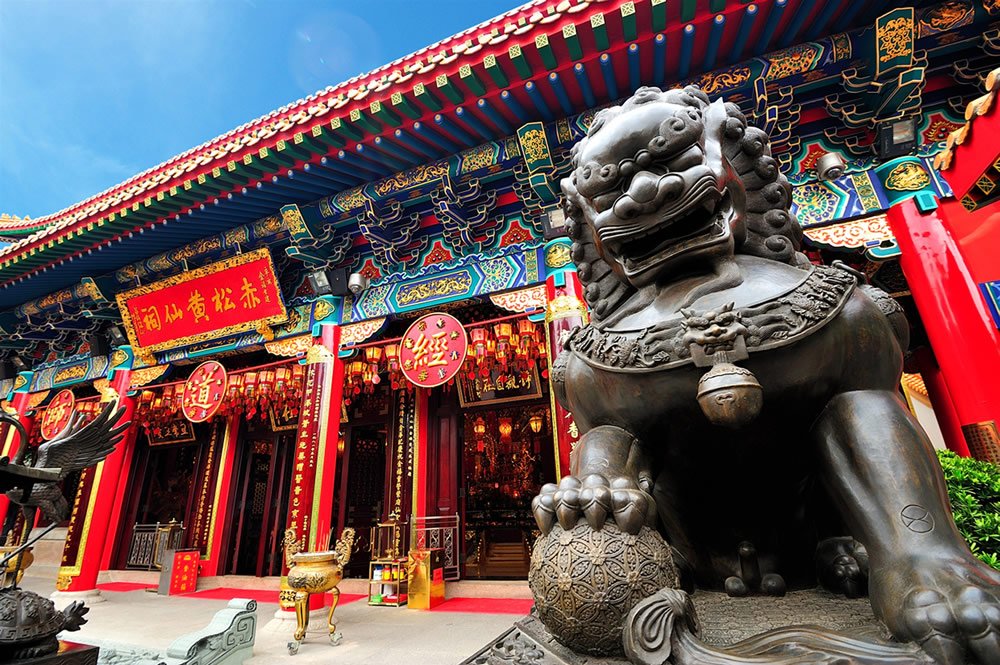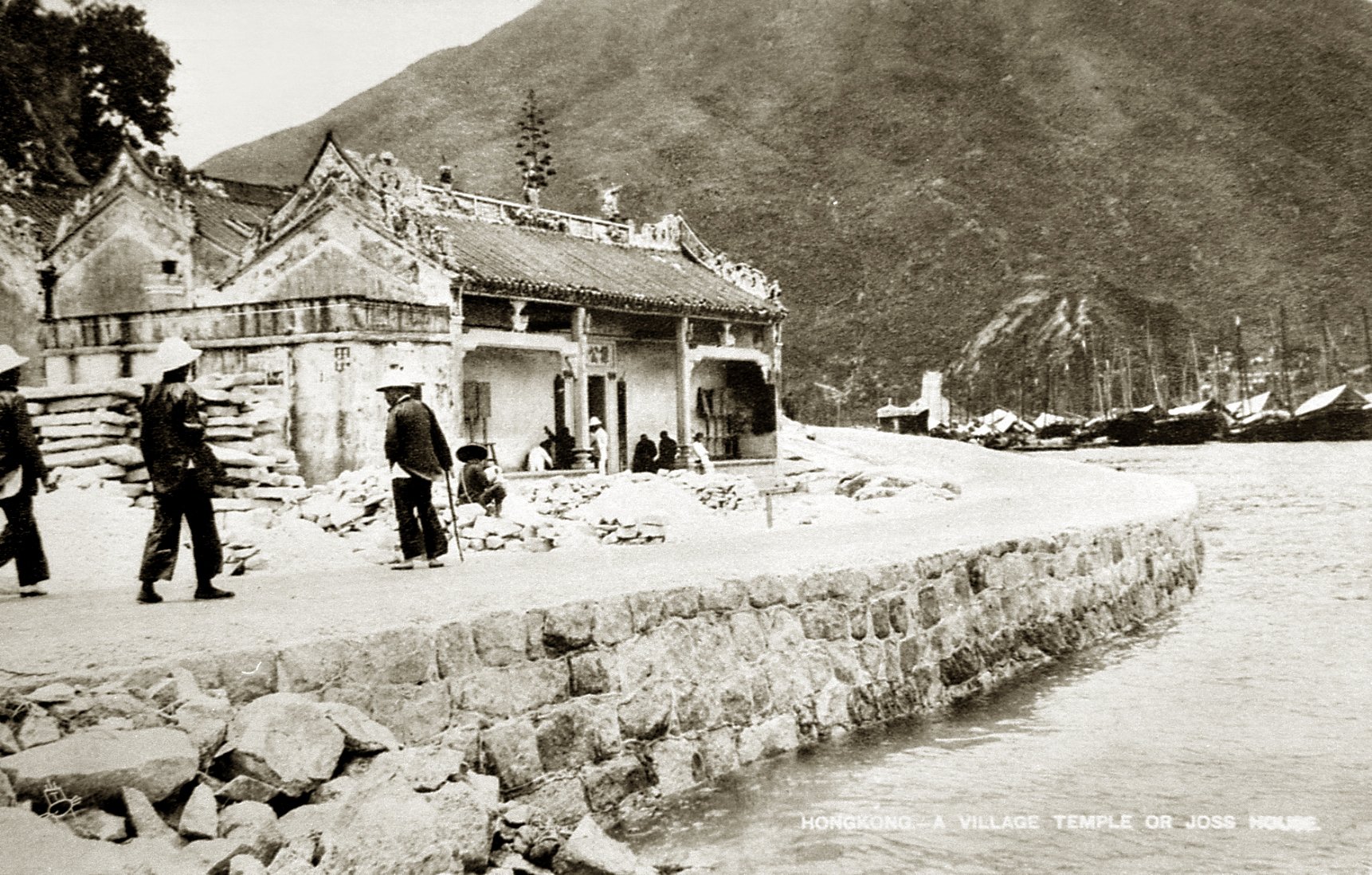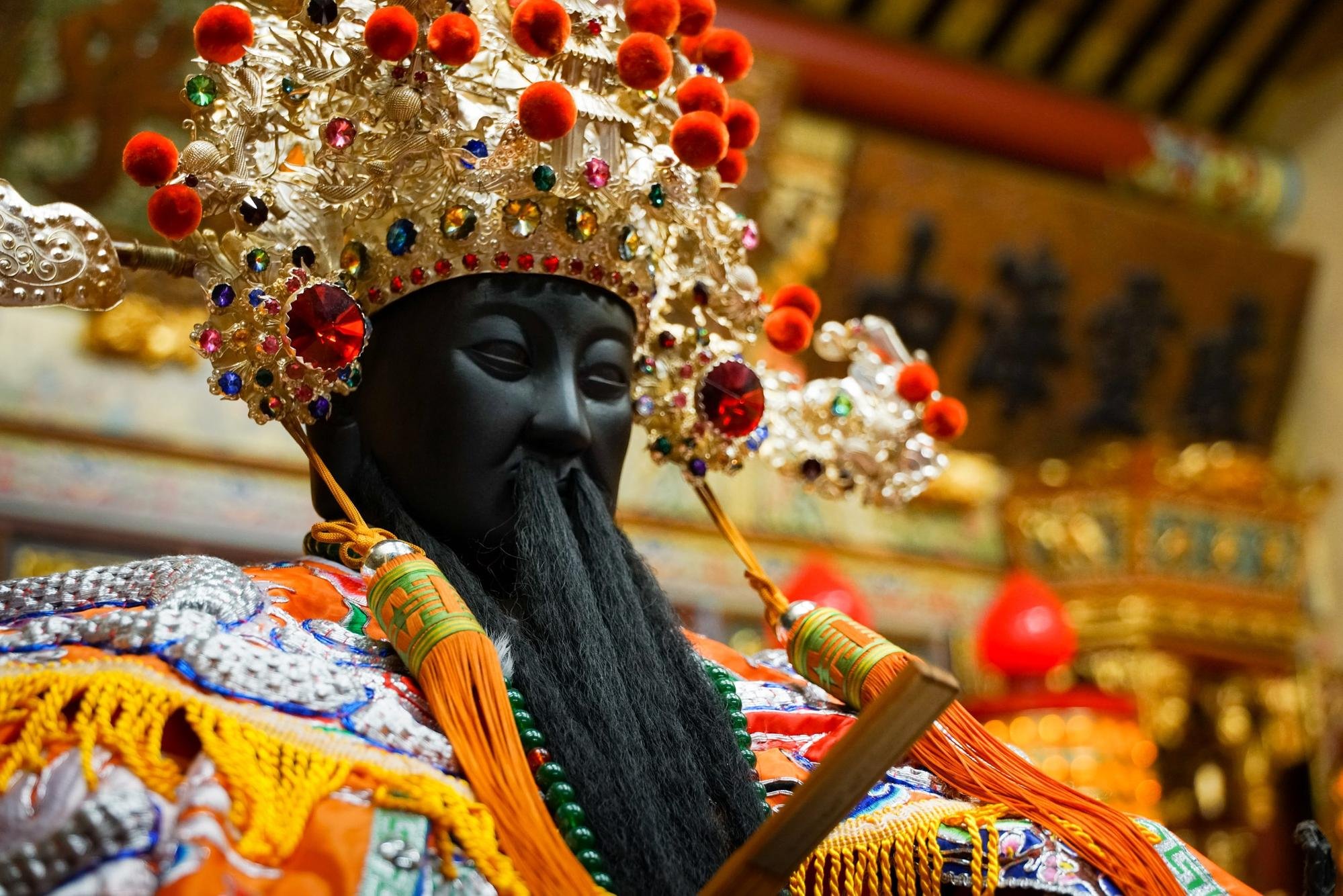Blurred Lines
Part II: Mapping Taoism, Buddhism, and Folk Deities
Wander through any Hong Kong street and you’ll find the air thick with the scent of burning incense from doorsteps, alley shrines, and shopfront altars. In Hong Kong, faith is not confined to temples or festivals, it’s embedded in the rhythms of daily life. Joss sticks, in particular, act as conduits between realms, used by Taoists, Buddhists, and even the non-religious to seek blessings, show reverence, or invite good fortune.
Shrines are everywhere: tucked into corners, perched on walls, nestled beside cash registers. Each one is a quiet testament to a syncretic spiritual landscape where gods, ghosts, and ancestors share space. In Hong Kong, belief is less about rigid doctrine and more about lived practice: fluid, pragmatic, and deeply personal.
Street shrine in Hong Kong (source: David Boté Estrada@flickr)
Harmony of Faiths
Unlike many societies where religious traditions are distinct, Hong Kong embraces a syncretic approach, blending Chinese folk beliefs, Taoism, Buddhism, and Confucianism into a fluid, everyday practice. Even those who consider themselves secular may burn incense at Wong Tai Sin Temple or seek blessings at a Buddhist monastery. This fusion extends beyond personal rituals, manifesting in the very names of streets, neighbourhoods, and mountain peaks. In Tuen Mun, Sam Shing Street (三聖街, "Three Saints Street") pays homage to a temple where Confucian, Taoist, and Buddhist figures are venerated side by side. It demonstrates how belief systems, which are often perceived as distinct, coexist in Hong Kong's spiritual landscape.
On the couplet: “A family of Confucians, Buddhists and Taoists, with three virtues: wisdom, benevolence and courage.” (Source: Hulu Culture)
Buddhism
Lantau's Spiritual Sanctuary
Among Hong Kong’s sacred sites, few command as much attention as the Tian Tan Buddha. Though the colossal bronze statue was erected only in 1993, Buddhism’s presence on Lantau Island dates back centuries.
During the late Qing Dynasty, monks fleeing political turmoil sought refuge in Lantau’s misty peaks, bestowing its mountains and valleys with names drawn from Buddhist tradition:
Nei Nak Shan (彌勒山, "‘Maitreya Mountain")
Kwun Yum Shan (觀音山, "Guanyin Hill")
Muk Yu Shan (木魚山, "Wooden Fish Hill")
Ling Hui Shan (靈會山, "Spiritual Meeting Hill")
At the heart of Lantau’s Buddhist heritage is Po Lin Monastery (寶蓮禪寺), first established as a simple retreat named "Big Thatched Hut" in 1906. Today, the monastery serves as a gateway to enlightenment for those seeking peace among the island's misty hills.
The BIG Buddha (source: Discover HK)
Wooden Fish aka Chinese temple block
From Tuen Mun to Diamond Hill
Pui To Shan (杯渡山), now Castle Peak in Tuen Mun, is Hong Kong's oldest recorded place name. It honours a wandering monk who introduced Buddhism to the region during the Northern and Southern Dynasties. Tuen Mun became a bustling new town in the 1980s, but his legacy remains on Pui To Road (杯渡道), a quiet reminder of the city's spiritual roots.
Chi Lin Nunnery (志蓮淨苑), located at the foot of Diamond Hill, exemplifies Buddhist craftsmanship. The monastery, founded in 1934 and rebuilt in 1998, is entirely made of cypress wood—without a single nail—and adheres to Tang Dynasty architectural principles. This harmonious design embodies the serenity that is central to Buddhism. The monastery's tranquil courtyard leads to an exquisitely landscaped garden, inspired by Jiangshouju Garden (絳守居園池) in Shanxi, where lotus flowers bloom beneath silent pagodas. The nunnery has left its mark on the surrounding streets, including Chi Lin Drive (志蓮道), which is named after it.
Chi Lin Nunnery when it was still Chan Chat Mansion (source: Chi Lin)
Chi Lin Nunnery now (source: Time Out)
Riding the Clouds of Compassion
Tsz Shan Monastery and the Kwun Yum statue (source: Artnet News)
No Buddhist figure holds greater affection in Hong Kong than Kwun Yum (觀音), the Bodhisattva of Compassion. In times of hardship, Hongkongers turn to her, seeking solace for matters of health, relationships, and fortune. The prominence of Kwun Yum is evident in the built environment of Hong Kong. Tsz Shan Monastery 慈山寺, completed and opened in 2015, is a notable example. Funded by the richest man in Hong Kong at over HK$3.3 billion, the monastery features an impressive 76-metre tall bronze statue of Kwun Yum.
Her influence permeates Hong Kong’s geography, woven into both grand temples and quiet corners:
Kwun Yam Street (觀音街) in Hung Hom
Kwun Yam Shan (觀音山) on Lantau Island
Kwun Yam Wan (觀音灣) in Cheung Chau
Even Tsz Wan Shan (慈雲山, “Compassionate Cloud Hill”) in Kowloon echoes her presence, named for the Kwun Yum temple on its slopes. Legend holds that Kwun Yum rides upon the mist curling over the mountain, an ethereal vision of mercy that lingers in the landscape.
An unintended tribute to her legacy can be found on Lily Street (蓮花街) in Tai Hang. Lin Fa Temple (蓮花宮, "Temple of Lotus"), dedicated to her worship, took on its current name due to a mistranslation. The reference to the lotus, Kwun Yum's sacred flower, is entirely appropriate, even if it was unintentional.
Lin Fa Temple was built in 1863 for the worship of Kwun Yum, taken in the 1870s (source: wiki)
Lin Fa Temple now
Taoism
Though Taoism originated in mainland China over 2,000 years ago, its influence on Hong Kong is visible not only in temples, but also in the names of its streets and neighbourhoods. Hong Kong's Taoist traditions combine "orthodox" figures like Laozi (老子) and Taishang Laojun (太上老君) with regional and national deities, resulting in a unique spiritual landscape.
Its local journey began in the 1880s when a Taoist priest from Guangdong founded Shun Yeung Sin Yuen (純陽仙院) on Lantau Island. As turmoil swept across China in the early 20th century, Taoist temples relocated to Hong Kong, solidifying the city's spiritual terrain. Among them were Fung Ying Seen Koon (蓬瀛仙館) and Ten Thousand Buddhas Hall (萬佛堂).
Fung Ying Seen Koon, founded in 1929, is a Taoist temple of the Quanzhen Longmen Lineage (全真龍門派). Named after two mythical islands in the Bohai Sea, it showcases exquisite Taoist design. Fung Ying Seen Koon in the late 1950s (source)
The Ten Thousand Buddhas Hall, built between 1912 and 1915 by a group of comb sisters from Nanhai, Guangdong. The side buildings served as living quarters, housing up to 60 women during its peak. (source: Master Insight)
Wong Tai Sin (黃大仙), the deity of fortune and healing, has become a symbol of Hong Kong's spiritual and geographical identity. Once a shepherd, he is said to have attained immortality and is now honoured in streets, districts, and the famous Wong Tai Sin Temple (黃大仙祠). The arrival of mainland refugees in 1949 accelerated the development of the area surrounding the temple, resulting in the naming of a MTR station and entire neighbourhoods after this revered deity.
Taoist temples in the New Territories influenced urban naming conventions, resulting in names such as Tsing Chung Koon Road (青松觀路) and Tsing Chung Path (青松徑). Other revered Taoist sites, such as Ching Chung Koon (青松觀) in Tuen Mun and Yuen Yuen Institute (圓玄學院) in Tsuen Wan, remain key pillars of Taoist tradition in Hong Kong.
Pray for luck at Wong Tai Sin Temple
First inaugurated at Wai Ching Street, Kowloon in 1950, Ching Chung Koon established its current permanent monastery in Tuen Mun in 1960 with the completion of Shun Yeung Din (純陽殿).
The former site of the Confucius free school, which is now the Tai Hang Fire Dragon Heritage Centre (Source: Discover HK)
Confucianism
More than a religion, Confucianism is the philosophical backbone of Hong Kong, influencing education, governance, and social values. Principles like filial piety, respect for elders, and moral discipline remain deeply embedded in the city's traditions.
Its formal presence began with the founding of the Confucian Academy (孔教學院) in 1930, though its roots stretch further back to the late Qing Dynasty, when the Confucius Free School (孔聖義學) was established to educate the underprivileged. Destroyed during World War II, the school was rebuilt in 1949, preserving Confucian ideals for future generations.
This legacy lives on in Tai Hang, where place names such as School Street (書館街) and Lai Yin Street (禮賢街) reflect the school’s historic influence. Today, the former Confucius Free School has taken on a new role as the Tai Hang Fire Dragon Heritage Centre, ensuring that tradition continues to burn brightly.
Folk Religions
As the city evolved from a fishing and farming economy into a bustling commercial hub in the early 20th century, worship practices flourished—shaping communities, livelihoods, and the very names of streets and places. Temples, villages, roads, and waterways reflect the reverence for deities who once safeguarded those dependent on the land and sea.
Tin Hau: The Goddess of the Sea
Tin Hau, Goddess of the Sea aka Mazu (source: wiki)
Among Hong Kong’s most revered deities, Tin Hau 天后, the Goddess of the Sea, is worshipped in over 80 temples across the city. Originally venerated by seafarers from Fujian, Taiwan, Guangdong, and Hainan, Tin Hau’s legend tells of a young woman from the Song Dynasty who possessed extraordinary foresight—able to predict storms and safeguard sailors. At just 29, she ascended a mountain and vanished, achieving immortality and securing her place as a maritime protector.
Hong Kong’s oldest and most famous Tin Hau Temple is in Joss House Bay, also known as Tai Miu Wan 大廟灣 (‘Bay of the Great Temple’), believed to date back to the Southern Song Dynasty. The surrounding geography reflects her influence: Fat Tong Mun 佛堂門 (‘Gate of Buddhist Temple’) in Sai Kung marks the channel between Joss House Bay (formerly 北佛堂 ‘North Buddhist Hall’) and Tung Lung Chau (formerly 南佛堂 ‘South Buddhist Hall’). Even Ma Wan 馬灣 and Ma Wan Chung 馬灣涌, both named after her nickname “Mazu” 媽祖—bear traces of her legacy.
Her presence extends beyond temples, permeating everyday city life through locations like Tin Hau Road 天后路, Miu Tung Street 廟東街, Temple Street 廟街, and the Tin Hau MTR station. These place names highlight Hong Kong’s deep-rooted maritime traditions and continued reverence for the goddess.
Tin Hau's birthday celebrations in Hong Kong, designated an Intangible Cultural Heritage by UNESCO in 2009, are a communal event based on China's Mazu belief system. The festival includes Cantonese opera, firecracker ceremonies, and grand procession, with the welcoming ceremony transporting Tin Hau's statue and lion dances. Land and sea parades add to the festivities.
Tin Hau Temple (天后古廟) was built by Hakka people from Guangdong in early Qing Dynasty. Legend says they constructed it after finding a floating incense burner. Tin Hau Temple in Causeway Bay circa 1870s (source: Gwulo)
Tin Hau Temple now
Hung Shing: The God of the South Sea
Hung Shing, aka the God of the South Sea
Just as Tin Hau protected sailors from treacherous waters, Hung Shing 洪聖, the God of the South Sea, safeguarded fishermen by mastering the forces of nature. A Tang Dynasty official renowned for his expertise in astrology and geography, his ability to predict weather patterns saved countless lives, earning him divine status after his passing. His temples flourished during the Qing Dynasty, and his legacy endures in Hong Kong’s geography—Hung Shing Yeh Beach 洪聖爺灣 on Lamma Island, Hung Shing Street 洪聖街 in Ap Lei Chau, and Tai Wong Street East and West 大王東西街 in Wan Chai all bear his name.
His influence extends beyond place names; his festival is still a vibrant tribute, combining sacred traditions with a lively spectacle. The local committees organise the celebration, which includes rituals, Cantonese opera, parades, and Taoist rites. Firecracker contests in villages that retain traditional customs involve competitors scrambling for bamboo sticks launched into the sky, while others choose raffles or divination draws. Bamboo theatres present Cantonese opera for both Hung Shing and the community, with his statue ceremoniously brought to the stage. Parades escort the deity through the streets of Ap Lei Chau, accompanied by lion and dragon dances, while some villages practise Taoist purification rituals to maintain harmony.
Hung Shing Temple (洪聖古廟) was built around 1847, and is one of the earliest temples on Hong Kong island. It is now a landlocked temple on Queen’s Road East in Wanchai.
Lotus lanterns floated gently as locals made their wishes, for calm seas, clear skies, and peace.
Pak Tai: The Warrior Emperor
The Supreme Emperor of the Dark Heaven (source)
More than a guardian of travelers, Pak Tai 北帝, Supreme Emperor of the Dark Heaven, shaped communities through righteousness and war. His legend tells of a celestial battle where he led twelve heavenly armies to defeat the Demon King, earning his divine title. He is depicted standing atop a serpent and a tortoise, symbols of his triumph over darkness.
Pak Tai’s connection to Hong Kong began with a mysterious discovery by fishermen in Cheung Chau, who found his statue entangled in their nets, interpreted as a divine sign. A temple was erected in his honour, lending his name to Pak She Street 北社街 and Pak She New Village 北社新村. Another key site, Pak Tai Street 北帝街, was originally home to a Pak Tai temple built in 1876. Though demolished in 1921 due to urban development, it was later reconstructed in Hok Yuen Kok near Pak Kung Street 北拱街, meaning ‘Protected by the Northern Emperor.’
Pak Tai’s legacy thrives in the Cheung Chau Bun Festival, born from islanders seeking protection from plagues and pirates. Today, it’s a grand spectacle of devotion and tradition. The bun-scrambling contest sees competitors scale towering bun-covered structures to seize symbols of luck and prosperity. The streets burst with the Piu Sik Parade 飄色, where children dressed as legendary figures appear to float above the crowds. At the heart of it all, Pak Tai Temple hosts martial arts performances, Taoist rituals, and offerings honoring his guardianship. Pak Tai's protection is woven into the heartbeat of Hong Kong's cultural identity, uniting generations under his watchful gaze.
Grab some buns (source: HK Gov)
Piu Sik Parade (source: HK Gov)
Tam Kung: The Child Prodigy God of Wind and Rain
Tam Kung holding some kind of symbolic object (source: HK Memory)
While Pak Tai commanded celestial armies, another revered figure, Tam Kung 譚公, was known for his uncanny ability to control wind and rain. A child prodigy worshipped by Hakka communities, Tam Kung’s legends tell of his miraculous deeds, such as vanquishing the Dragon God to save people from devastating floods.
His presence in Hong Kong is strongest in Shau Kei Wan, where Hakka fishermen and stonemasons established an altar on A Kung Ngam 亞公岩 (‘Rock of the Revered Elder’), later evolving into the Tam Kung Temple. The road adjacent to it, Tam Kung Temple Road 譚公廟道, bears his name. His divine protection is credited with shielding the temple from destruction during the 1941 Japanese invasion and miraculously extinguishing a fire nearby in 1946.
Elsewhere, another Tam Kung Temple in To Kwa Wan, Kowloon, was originally built by water-dwelling communities in the 19th century. Though lost during World War II, the area remains marked by Tam Kung Road 譚公道.
Tam Kung Temple in Shau Kei Wan in the 1920s (source: HK Memory)
The now landlocked Tam Kung Temple in Shau Kei Wan (source: wiki)
Shing Wong: The City God
Hong Kong’s geography is not only shaped by maritime deities but also by divine bureaucrats who preside over urban affairs. Shing Wong 城隍, the City God, symbolises protection and governance. During the Ming dynasty, Emperor Zhu Yuanzhang decided cities needed more bureaucracy, assigning a hierarchy of City Gods across various regions to oversee the underworld and safeguard the living.
Hong Kong’s first Shing Wong Temple appeared in 1842 in Sheung Wan but was lost in a typhoon. Its statue was transferred to Man Mo Temple, and the temple site repurposed as Shing Wong Street 城皇街. Interestingly, when street names were standardised in the early 20th century, officials mistakenly changed the 隍 character to the homonymous 皇 (‘imperial’), assuming the area was named after Queen's College.
Even this deity can’t escape from bureaucracy from hell (source)
Yau Ma Tei Shing Wong Temple was built by local fishermen in 1865, and relocated to the current spot in 1876. (source)
Hau Wong: The Loyal Marquis
Hau Wong, the one who fled to Kowloon and became a deity
In the southern Guangdong region, the Hau Wong 侯王 belief centres around temples dedicated to historical figures, often military leaders from the Song Dynasty. These temples are intricately linked to the area's military defence history, as they were typically constructed near former military outposts and sites where legendary generals had once stationed their troops.
One such figure is Yang Liangjie 楊亮節, a general who fought against the invading Yuan Dynasty forces. After suffering defeat, Yang sought refuge in the Kowloon peninsula. Recognising his bravery and loyalty, the local residents built a temple near Kowloon City to honour Yang, with Hau Wong Road 侯王道 located nearby. Similarly, other Hau Wong temples can be found in places like Tung Chung and Tai O, each with its own historical connection to the military leaders of the Song era who fought to defend the region.
Hau Wong Temple in Kowloon City (九龍城侯王古廟) was built in 1730 or earlier and was patronised by Qing officials and soldiers from the Kowloon Walled City. Hau Wong Temple in the 1920s (source: Gwulo)
Hau Wong Temple in Kowloon City now
Che Kung: The Epidemic Dispeller
Che Kung Temple (車公廟) was built pre-1890. The temple's famous windmill is believed to bring luck. An expansion in 1993 made the new temple eight times larger, with the old temple now occasionally open to the public. (source: wiki)
Che Kung 車公, a revered general from the Song Dynasty, is celebrated for his role in protecting local communities and dispelling epidemics. Over time, his influence expanded from a village protector to a regional deity, with his temples becoming significant cultural and religious symbols in Hong Kong.
It was said that during the late Ming Dynasty, an epidemic in Sha Tin led residents to discover historical accounts describing Che Kung's reputation for clearing epidemics wherever he travelled. Inspired by these stories, the people of Sha Tin decided to build a temple to honour the general. Legend has it that the epidemic subsided on the very day the construction of the Che Kung Temple was completed. Today, two of the most prominent Che Kung temples can be found in Sai Kung and Sha Tin, with a nearby street named Che Kung Miu Road 車公廟路 in recognition of the deity's legacy.
Che Kung's birthday celebration is a whirlwind of fate and fortune, with worshippers flooding his temple on the second day of the Lunar New Year, clutching incense sticks and twirling pinwheels, hoping to tip the scales in their favour. The frenzy of fortune-telling is in full swing with drums pound, pinwheels whirl, and divination sticks reveal cryptic results. Some seek guidance from experienced fortune tellers, while others rely on the luck of a printed slip. Meanwhile, the Heung Yee Kuk and Sha Tin Rural Committee compete for larger stakes, drawing fortune sticks not only for themselves, but for entire districts. Their grand entrance, which includes qilin dancers, solemn kneeling, and the rhythmic thud of drums, culminates in a celestial reading that combines superstition, tradition, and a hint of political theatre, before they exit with symbolic windmills in hand, ready to seize control of fate.
Spinning wheels for luck
Designated scapegoat
While Tin Hau, Hung Shing, Pak Tai, and Tam Kung are traditionally regarded as water deities, their influence extends beyond coastal and maritime communities, as they are also worshipped by those living on land. In contrast, land-based deities like Shing Wong, who presides over urban affairs, Hau Wong, revered for his military defense, and Che Kung, known for his ability to dispel epidemics, serve as protectors of settlements and cities. Yet beyond these divine guardians of human communities, some deities hold dominion over the land itself—ensuring stability, prosperity, and safe passage for those who traverse it.
To Dei Gong: The (Down-to-) Earth Deity
The tiny To Dei Gong shrines you probably walk past everyday
The worship of earth deities has been an integral part of Chinese culture for centuries, rooted in the agricultural traditions that shaped village life. Known by various names such as "To Dei Gong 土地公," "She Shen 社神," "Tai Wong 大王," "Fook Tak Gong 福德公," and the Hakka term "Pak Kung 伯公," these gods were not tied to grand mythological figures but rather emerged from a practical need for protection.
By the Zhou Dynasty, the worship of earth gods had already developed into a structured sacrificial system, and by the Han Dynasty, most towns and villages had erected altars to honor them. Unlike temples dedicated to celestial deities, earth god shrines are modest structures placed strategically in village entrances, roadsides, or beneath trees, quietly watching over travelers.
Their presence in Hong Kong is marked by simple shrines scattered across trade routes and mountain passes, serving as protectors of those navigating the terrain. There are at least four locations named "Pak Kung Au 伯公坳" in Hong Kong, the most notable being on Lantau Island. Other sites include Tai Lam in Yuen Long, Sai Kung, and the Sha Tau Kok Border Closed Area. Even entire villages, such as Tai Wong Ha and Sheung Tsuen 大王上下村 in Tsing Yi, carry the legacy of earth deity worship in their names.
Take a Tour
Hong Kong's diverse religious practices and rituals mirror its rich cultural landscape. While modernisation has reshaped some traditional customs, the deep-rooted influences of Buddhism, Taoism, Confucianism, and folk religions continue to shape both the city's urban landscape and the daily lives of Hong Kongers. As the city continues to evolve, these time-honoured traditions and beliefs will undoubtedly adapt and evolve alongside it.
Explore the map for more information about streets and places named after Chinese religions and deities:
Next Up
In the next chapter, we will explore the influence that other religions, particularly Christianity, have had on Hong Kong's socioeconomic development and urban landscape — from the development of public housing to the inspiration behind one of the most celebrated Chinese science fiction adventure series.
